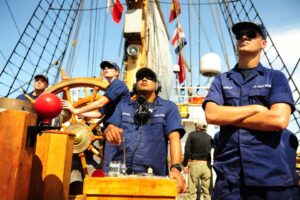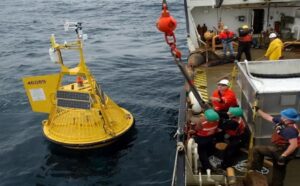The views expressed herein are those of the author and are not to be construed as official or reflecting the views of the Commandant or of the US Coast Guard.
The US Coast Guard is the premier agency promoting US Foreign Policy and Maritime Security Cooperation throughout Oceania and this mission could be strengthened by deploying NOAA scientists onboard their vessels. Climate change presents an existential threat to Pacific Island nations, frames Oceanic regional security dialogue, and provides an opportunity to strengthen partnerships with the US and allies. The Pacific Islands Forum’s 2050 Strategy for the Blue Pacific Continent highlights and prioritizes Pacific leaders’ commitment to “protect our sovereignty and jurisdiction over our maritime zones and resources, including in response to climate change induced sea level rise, and strengthen our ownership and management of our resources.” The Pacific Partnership Strategy of the United States, published in September 2022, promotes 10 lines of efforts, including: “combat the climate crisis and build climate resilience in the Pacific; support marine conservation, maritime security, and sovereign rights; and partner with Pacific Islanders to strengthen People-to-People ties and seize 21st century opportunities.” To encourage mutually beneficial relationships with Pacific Islands nations, the US should broaden existing maritime security operations to address climate security concerns through science outreach and information-sharing. A USCG-NOAA science shiprider program would provide an opportunity to promote Pacific Island partners’ resiliency through established interagency operations that bridge maritime law enforcement and science diplomacy.
The Current USCG – NOAA Relationship
The USCG and NOAA share a robust and extensive cooperative relationship. NOAA operates within the US Department of Commerce with a mission “to understand and predict changes in climate, weather, ocean, and coasts, to share that knowledge and information with others, and to conserve and manage coastal and marine ecosystems and resources.” The USCG is a “multi-mission, military, maritime service” within the US Department of Homeland Security which serves as “humanitarian first responders, environmental stewards, a law enforcement and regulatory agency, a member of the intelligence community, and a branch of the Armed Forces.” The partnership between the two agencies is codified by the 2013 Cooperative Maritime Strategy, 2014 Fleet Plan, 2020 National Weather Service Memorandum of Agreement, and the US Interagency Working Group on IUU Fishing established by the Maritime Security and Fisheries Enforcement (SAFE) Act.

NOAA Corps Basic Officer Trainees onboard the US Coast Guard Cutter Barque Eagle. Photo: USCG
The scope of interagency cooperation ranges across the spectrum of each organization’s responsibilities. The USCG works with NOAA’s “Office of Response and Restoration, the Office of Law Enforcement, NOAA Fisheries, and the NOAA Corps.” The USCG and NOAA coordinate for training, oil spill response, weather buoy maintenance, and law enforcement. NOAA Corps Basic Officer Training Class, an entry requirement for all officers, convenes at the US Coast Guard Academy in New London, CT and trains alongside the USCG Officer Candidate School.
Furthermore, NOAA employees embark on Coast Guard vessels, known as Cutters, to conduct joint operations. NOAA’s National Data Buoy Center manages 1,300 weather monitoring stations, including “a system of tsunami warning buoys around the equator in the Pacific Ocean.” The weather buoys are serviced and maintained by Coast Guard and NOAA National Weather Service technicians. Likewise, members of NOAA’s Office of Law Enforcement serve alongside USCG personnel to enforce Living Marine Resources and National Marine Sanctuary regulations.

Coast Guard and NOAA personnel servicing a NOAA weather monitoring buoy onboard a Coast Guard Buoy Tender. Photo: USCG
The Opportunity for a USCG-NOAA Shiprider Program in Oceania
Adding a NOAA scientist to Coast Guard Cutters, when conducting law enforcement operations in Oceania, provides a force multiplier by promoting science outreach and regional climate security. The USCG and NOAA both conduct operations to support Pacific Island nations’ sovereign rights, maritime law enforcement capacity, and resiliency. Coast Guard Cutters regularly deploy from California, Hawaii, and Guam to support Forum Fishery Agency (FFA) operations, such as Operations Rai Balang and Kurukuru, exercise bilateral agreements, enforce Western and Central Pacific Fisheries Commission Conservation and Management Measures on the High Seas, and conduct regional port calls. When conducting future deployments, an embarked NOAA scientist could deliver exportable climate change modeling, fisheries/natural resource management briefings, earthquake/tsunami risk assessments, critical habitat risk modeling, and/or science outreach workshops to Pacific Island communities. These in person presentations could strengthen people-to-people ties, encourage cooperation between the US and Pacific Island partners, and promote awareness and resiliency. Embarking civilian scientists is regularly practiced by the Coast Guard, exemplified by the Cutter Healy, which hosted 34 civilian scientists during a 2022 Arctic patrol.
Regularly scheduled joint science outreach and maritime rule of law engagements, tailored in collaboration with Pacific Island communities, in support of FFA operations or in conjunction with exercising bilateral agreements, would promote mutual Pacific Islands Forum and US Government objectives. While not a strategic solution to address all regional challenges, a shiprider program bridging environmental and maritime security concerns demonstrates US commitment to the region and a shared prioritization of security concerns. A USCG-NOAA science shiprider program could be an implementable and exportable process to provide capacity-development services when desired by Pacific Island partners. Simultaneously delivering environmental security, fishery, and maritime sovereignty outreach would demonstrate the US commitment to the Blue Pacific Continent and create an opportunity to promote mutually beneficial resiliency, stability, and security.
Tony Seleznick ([email protected]) is a Central Assignment Coordinator for Enlisted Personnel Management at Personnel Service Center in Washington, D.C. He was also a participant in the 2022 Young Pacific Leaders Workshop on Marine Sustainability.
Disclaimer: All opinions in this article are solely those of the author and do not represent any organization.







